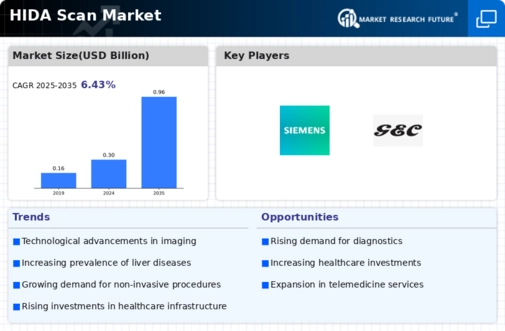Market Analysis
In-depth Analysis of HIDA Scan Market Industry Landscape
The market dynamics of the HIDA (hepatobiliary iminodiacetic acid) scan market are influenced by a combination of factors that collectively shape its growth and trends. HIDA scan, a diagnostic imaging procedure used to evaluate the functioning of the liver, gallbladder, and bile ducts, plays a crucial role in detecting various hepatobiliary disorders. The market is primarily driven by the increasing prevalence of liver and gallbladder diseases, including infections, tumors, and functional abnormalities. As these conditions become more prevalent globally, the demand for accurate and non-invasive diagnostic tools like HIDA scans continues to rise.
Technological advancements in medical imaging also contribute significantly to the market dynamics. Continuous improvements in imaging resolution, diagnostic accuracy, and patient comfort enhance the overall appeal of HIDA scans. The integration of advanced technologies, such as single-photon emission computed tomography (SPECT) and hybrid imaging modalities, further expands the diagnostic capabilities of HIDA scans. This continuous innovation not only attracts healthcare providers but also broadens the scope of applications, reinforcing the market's growth trajectory.
Government initiatives and healthcare infrastructure development also play a pivotal role in shaping the HIDA scan market. Increased awareness of liver diseases, coupled with government efforts to improve healthcare access and affordability, encourages the adoption of diagnostic procedures like HIDA scans. In addition, the growing importance of preventive healthcare drives the demand for early and accurate diagnosis, boosting the market further. Reimbursement policies and favorable regulatory frameworks also influence the market dynamics by facilitating easier access to HIDA scans for patients.
The competitive landscape significantly impacts the HIDA scan market, with various companies vying for market share through product innovation and strategic collaborations. Companies invest in research and development to introduce new and improved imaging agents, equipment, and software, aiming to stay ahead in this dynamic market. Strategic partnerships with healthcare institutions, distributors, and technology providers enable market players to expand their reach and enhance their overall market presence. Price competition, service quality, and customer support also contribute to the competitive dynamics, as healthcare providers seek cost-effective solutions without compromising diagnostic accuracy.
Global economic factors, such as fluctuations in currency exchange rates and healthcare spending patterns, add another layer of complexity to the HIDA scan market dynamics. Economic downturns may impact healthcare budgets, affecting the adoption rates of diagnostic procedures. However, the increasing awareness of liver diseases and the importance of early detection often outweigh economic challenges, ensuring a sustained demand for HIDA scans.
Moreover, demographic trends and population health factors influence the market dynamics. The aging population, particularly in developed regions, contributes to the rising incidence of liver-related disorders, creating a consistent demand for HIDA scans. Lifestyle changes, including dietary habits and alcohol consumption, also play a role in shaping market dynamics, as they contribute to the prevalence of liver diseases.





Leave a Comment